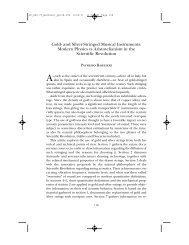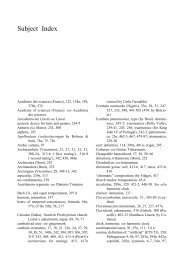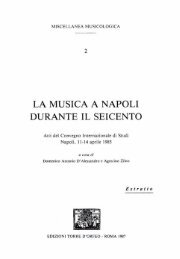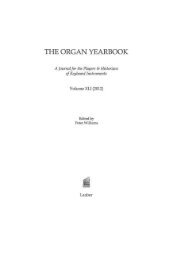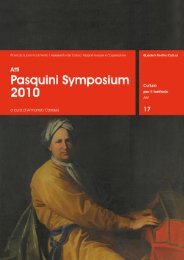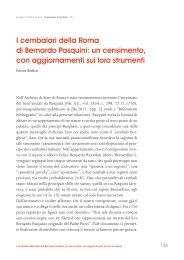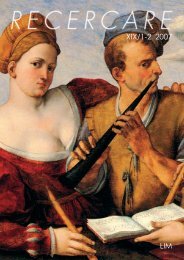Music-selling in seventeenth-century Rome: three ... - Patrizio Barbieri
Music-selling in seventeenth-century Rome: three ... - Patrizio Barbieri
Music-selling in seventeenth-century Rome: three ... - Patrizio Barbieri
You also want an ePaper? Increase the reach of your titles
YUMPU automatically turns print PDFs into web optimized ePapers that Google loves.
<strong>Music</strong>-<strong>sell<strong>in</strong>g</strong> <strong>in</strong> <strong>seventeenth</strong>-<strong>century</strong> <strong>Rome</strong> 141• Virgilio Mazzocchi: [III: 179] Chi soffre speri, Roma 1637 (commedia musicale);[III: 174] S. Bonifazio, Roma 1638 (rappresentazione spirituale); [III: 178] LaGeno<strong>in</strong>da, Roma 1641 (opera musicale); [III: 168] Il Sant’Eustacchio […], Roma1643 (azione <strong>in</strong> musica).• Domenico Mazzocchi: [III: 167] Il martirio de’ Santi Abundio […], Roma 1641(sacred opera).• Giovanni Antonio Carpani: [III: 175] S. Cecilia, Roma 1660 (sacred drama).• Raffaele Libelli: La Galatea (unknown work, already mentioned <strong>in</strong> <strong>in</strong>v. 1676,and therefore not Loreto Vittori’s Galatea).2.3. The publishers: Venice vs <strong>Rome</strong>. Just as with the <strong>in</strong>ventory of the bookseller Pierodi Giuliano Morosi of Florence (late 1580s or early 1590s, and possibly after 1592),<strong>in</strong> the case of the Franz<strong>in</strong>i too (1586) almost all the musical publications came fromVenice, then the European capital of the music pr<strong>in</strong>t<strong>in</strong>g trade (Table 2). 37 The Franz<strong>in</strong>iwere facilitated <strong>in</strong> this ow<strong>in</strong>g to their Veneto orig<strong>in</strong> and, probably, also to thepresence <strong>in</strong> <strong>Rome</strong> of not a few pr<strong>in</strong>ters from the same area (see, for example, Basa,Coatt<strong>in</strong>o, Alessandro Gardano, the Zannetti). Nor can we exclude the possibility thatsome of the works came directly from Brescia itself, the native town of the Franz<strong>in</strong>i,of Carampelli and the Zannetti. Indeed, we may recall that <strong>in</strong> 1586 Angelo Gardanostated that he had sent “piles of music books every week” to Brescia. 38Table 2. Publishers from different cities <strong>in</strong>dicated <strong>in</strong> the <strong>in</strong>ventories, as percentages (valuation<strong>in</strong>cludes only the 1st edition of each work).<strong>in</strong>ventoryyearvenice%rome%other italian cities%1586 94 1 4 11621 45 40 12 31633 69 19 7 51676 65 23 11 1foreign cities%Only a few years later, however, <strong>Rome</strong> began to ga<strong>in</strong> ground, due <strong>in</strong> particularto Nicolò Muzi (Mutij) and Alessandro Gardano: <strong>in</strong>deed, their editions are sold bythe booksellers operat<strong>in</strong>g <strong>in</strong> the City, such as Giacomo Bericchia (1591) and Paol<strong>in</strong>oArnolf<strong>in</strong>i (1596). 39 In the 1621 Franz<strong>in</strong>i <strong>in</strong>ventory, we also see that <strong>Rome</strong> almostmanages to rival Venice, this time thanks to the publish<strong>in</strong>g activity of pr<strong>in</strong>ters suchas Zannetti, Soldi and, most of all, Robletti (<strong>in</strong> the said <strong>in</strong>ventory Nicolò Muzi isalmost absent, probably because he sold his editions himself). 40 Bear<strong>in</strong>g <strong>in</strong> m<strong>in</strong>d that37. On Morosi, see carter, “<strong>Music</strong>-<strong>sell<strong>in</strong>g</strong> <strong>in</strong> late sixteenth-<strong>century</strong> Florence”, p. 489.38. carter, “<strong>Music</strong>-<strong>sell<strong>in</strong>g</strong> <strong>in</strong> late sixteenth-<strong>century</strong> Florence”, p. 491.39. barbieri, “<strong>Music</strong> pr<strong>in</strong>ters”, pp. 98–100. On the difference between music presses <strong>in</strong> <strong>Rome</strong> andVenice, see jane a. bernste<strong>in</strong>, “Publish or perish? Palestr<strong>in</strong>a and pr<strong>in</strong>t culture <strong>in</strong> 16th-<strong>century</strong> Italy”,Early <strong>Music</strong>, xxxv, 2007, pp. 225–235: 233–234.40. On Muzi, see franchi, “Cartolai editori di musica nel Seicento romano”, p. 37.



